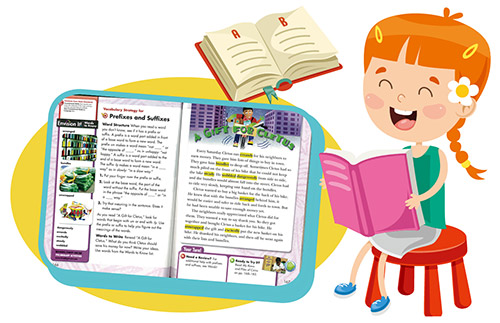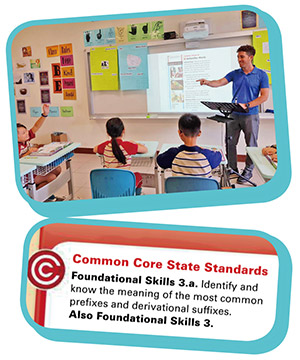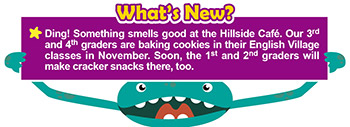
Engaging Active Vocabulary Learning
國際處主任 賴國宜
What would you do if you encountered an unknown word in a reading? Check in a dictionary? Our curriculum coordinator, Ms. Wei, explains that instruction in vocabulary strategies, such as analyzing word structure or using context clues, provides students with skills to independently determine the meanings of unfamiliar words. With phonics skills and vocabulary strategies, students develop vocabulary growth, which eventually enhances their reading comprehension.
Every year, the staff and teachers organize various activities for students to celebrate the KCIS School Anniversary. This year, the grade 3 students made a difference by designing their own Halloween activities for the school anniversary. Through this process, the students not only learned the skills for organizing and planning a game, but by switching roles from game players to designers, they also experienced seeing things from a wider perspective.
After all the fun activities for the school anniversary, the mid-term assessments are just around the corner. Now is time to warm up the brain and get ready for the tests!
在台灣,一般的英文教學並不重視詞彙學習策略,碰到困難的單字通常只會要求學生反覆背誦。上一期Ms. Wei說明了如何運用字母拼讀學習拼字,這一期她繼續闡述良好的詞彙學習策略,可以幫助字義的學習和單字量的累積,例如:分析單字的字根、字首和字尾來確認字義,從上下文來推敲不認識的單詞意義。從低年級的字母拼讀,到中高年級的詞彙學習策略,我們有計畫地將單字學習和閱讀理解結合,培養孩子建立自己字彙量的能力,進而成為高效能的閱讀者。
萬聖節闖關活動是每年校慶最受學生期待的活動之一,三年級的中籍英師將英語專題結合校慶,邀請孩子們發揮創意幫自己規劃最好玩的闖關活動,他們從玩家的身分轉換成遊戲設計者,發現遊戲除了要好玩,還要兼顧安全、器材、場地、遊戲規則,甚至還要規劃關主的職責。校慶當天,老師們把被評選出來的兩組最佳遊戲,真的布置成闖關活動,從門口等待入場的長龍,就可看出遊戲受歡迎的程度,希望您從照片可以一窺當日遊戲的盛況,也推薦您閱讀其他學生的作品,欣賞孩子們的無限創意。
一連串歡樂的校慶活動之後,就是期中評量了,趕快好好收心,希望每個孩子都能有好的表現。

~ Tina Wei
Curriculum Coordinator, International Department

In addition to the main readings, paired readings, and comprehension skill readings, students in grades two to six also read vocabulary strategy readings in their Reading Street textbooks. These one-page readings have corresponding strategies that students learn as tools to help them analyze parts of the story.
Analyzing Vocabulary Words
Understanding the vocabulary words is an essential part of reading comprehension. For vocabulary strategy readings, teachers begin by introducing a certain component of a word. They guide the students to identify context clues or word structures that can help them decode the meanings of words.

For example, when students read a text, they might come across words with multiple meanings. Students practice looking at nearby words and sentences to figure out the correct meaning. Students also learn to break down the word structure in order to figure out the meaning of the word using the prefix, base word, or suffix. This equips the students with the ability to decode the content and to gain and gather vocabulary knowledge independently.
Students also learn how to use a dictionary and glossary to look up words. We are teaching the students to actively find ways to figure out the significance of a word in the text rather than skipping words they don’t understand.
These strategies align with the Common Core State Standards for English Language Arts and is a formative assessment of students’ reading comprehension. The short length of the readings allows students to focus on applying and practicing one strategy at a time.
Checking for Comprehension
To supplement the students’ learning, we provide reading comprehension questions for the grades three and four vocabulary strategy readings online. Students can refer to the readings for textual evidence as they answer the five multiple-choice questions at home. The questions remain online for three weeks and students can choose to retake the questions (for a maximum of ten times) to ensure that they have a deep understanding of the text.

In Grade 3, the readings are read in class first before students have access to the questions online. In Grade 4, the readings are not read in class and this serves as a good unseen reading practice for the students.
Critical Thinking and Reading
Simply reading the text multiple times does not guarantee a comprehension of the text. The strategies will provide students with the ability to independently unpack the text for understanding. They can then critically think about what they are reading. We want to help students learn to read AND love to read so that they become confident readers and critical thinkers. We encourage the students to apply these strategies to the main and paired readings as well as other texts they come across so that critical thinking becomes a habit.

![]() 全文下載)
全文下載)